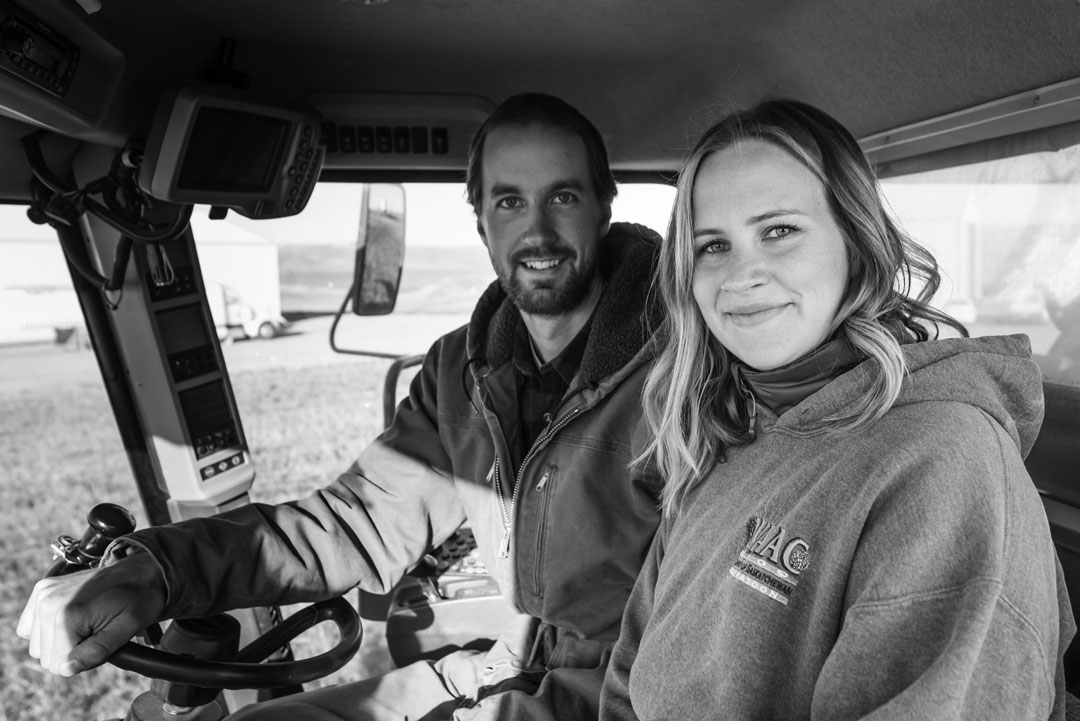LOCKED OUT OF R2R
BY CULLEN BIRD • PHOTO BY ROB MCMORRIS PHOTOGRAPHY
Mid-harvest is the worst time for an equipment failure, but that is what happened to Hannah Konschuh as she combined wheat on her family’s farm east of Strathmore last year.
The Case IH 9230 combine flashed three error codes across its monitor. Konschuh checked the owner’s manual, which advised her to call an authorized equipment dealer. “And there’s really no information given about what’s going on, or how to fix it,” she said.
It was an experience familiar to many Alberta farmers: an equipment software problem they can’t resolve causes unexpected downtime during critical fieldwork.
Konschuh concluded her machine’s problem had to do with the diesel exhaust fluid system that manages emissions. Anxious to finish harvesting, she continued to run the combine, but the error codes reappeared three times and the combine went into low-power “limp mode.” It was impossible to continue the harvest.
Without more information on the nature of the problem, she had no option but to call the dealership the next day. The technician arrived hours later and cleared the codes but the cause of the error remained undetermined.
The diagnosis and repair bill came to about $1,300. Konschuh, a Cereals Canada representative for the Alberta Wheat Commission, calculates she lost four to six hours of combine time. “With the weather the way it is at harvest time in Alberta, every hour counts,” she said. “The ability to service that machine ourselves, or have the choice of where you want to go and who you want to deal with to fix it, is really important. And that’s not really a choice we have right now.”
PROBLEMS IN CODE
The issue has been building in Alberta for years as farmers purchase new equipment with on-board computers that feature proprietary software.
“I’d say sometime around the late 2000s this started becoming a clear concern for farmers,” said Geoff Backman, manager, business development and markets with the Alberta Wheat and Barley Commissions. “Farmers bring it up as one of the reasons they’re hesitant to adopt new machinery.”
Ward Toma, general manager of Alberta Canola, said he has heard such complaints from farmers for more than a decade. “It’s getting more and more noticeable every year,” he said It is particularly galling for those who can fix their machines. “Some farmers are very good high-tech mechanics,” said Toma.
Konschuh appreciates her combine’s technological innovations. The amount of grain her family operation can thresh in an hour is amazing, she said, as is the quality of the harvested grain. However, this comes at the price of near-total reliance on the original equipment manufacturers and authorized dealerships for service and repair.
“If you think of the investment we make in those machines, we should have the ability to choose how to service them,” she said. Likewise, if a farmer wants a third-party business to service a machine without violating a warranty, they should have that right, too, she said.
If farmers can’t have diagnostic tools and services available for their own use, they put their operational fate in the hands of others.

TOOLS FOR THE JOB
In the U.S., in 2018, the Far West Equipment Dealers Association and farm equipment manufacturers committed to make diagnostic and repair tools accessible to authorized dealerships and third-party repair shops by January 2021. Whether or not this right-to-repair (R2R) commitment was met varies according to whether you speak to farmers and farm advocates or industry and its supporters.
“The tools are there, they’re just not available for sale to farmers,” said Backman. “The [repair] manuals available to farmers are available at an extremely high price point.” For example, a paper or CD copy of the diagnostic technical manual for John Deere combine models 9570 STS, 9670 STS, 9770 STS and 9870 STS costs USD$1,052.35, according to the company’s online Technical Information Store. The repair manual for the same models, which is sold separately, costs USD$266.64 for paper or CD copy and USD$253.31 for download.
The industry response to this is such tools are available for sale to farmers in the form of diagnostic tools from dealerships or online diagnostic services. “I’ll be the first to admit, as an industry, we could have done a better job of preparing equipment dealers for this rollout,” said John Schmeiser, CEO of the Western Equipment Dealers Association, which is unrelated to the similarly named U.S. organization.
However, while dealerships may have been slow to purchase the diagnostic software tools and repair manuals from manufacturers and make them available to customers, they are there now, he said. “Everything a dealer can purchase from a manufacturer—and that’s special tools, repair manuals and diagnostic equipment—is now available to a farmer or a third-party repair shop, if they want to purchase those items,” said Schmeiser.
As an example, he cited John Deere’s Customer Service ADVISOR, a software tool that dealerships can purchase from the company for resale to customers who want in-depth diagnostic and repair capability. He also cited online diagnostic services such as John Deere’s JD-Link.
John Deere has 100 per cent met its 2018 commitment to provide comprehensive repair and diagnosis options to customers, said Jonathon Ebert, manager of North American industry and public relations at John Deere.
“Customers that have the JD-Link enabled equipment, get access to diagnostic codes and information on their machines straight to their phone or straight to their computer, through that 4G connection to the cloud,” said Ebert. “And that will allow you to do some basic-level diagnosing of what those codes are and what they represent.”
Unfortunately, JD-Link only works when farmers have somewhat consistent access to a 4G internet connection, which can be sketchy in the field.
As for the high price points for repair manuals, Ebert said they reflect the precision and quality of information that equipment manufacturers want to provide for their customers. “There is significant time and energy that goes into ensuring we’ve got a robust set of information to a customer when they do make those purchases,” he said.
IMPORTED RIGHTS
At time of publication, a federal R2R bill had passed second reading in Parliament. Introduced by Liberal MP Bryan May, the bill seeks to amend the federal Copyright Act to allow consumers to diagnose, repair or tinker with their electronics and smart devices. The bill offers very limited circumventions of the original Copyright Act but may pave the way for true R2R bills to be introduced provincially. A 2019 private member’s bill introduced by Liberal MP Michael Coteau targeted R2R for electronic products but was not passed.
R2R is much bigger than farm equipment, of course. It includes cellphones, cars, consumer electronics and appliances. The potential effect of R2R legislation on many industries and corporate interests has made it a hotly contested issue among farm advocates and the equipment industry.
“In this spring session 2021 in the U.S., R2R bills were introduced in over 40 states, but none of them have passed,” said Schmeiser. “And we don’t anticipate that any of them will pass in the near future. The reason why is when you look at the language that is in these bills that are coming from the R2R advocates in the U.S., their intent in the language is to modify our equipment.”
The charge that R2R is a Trojan horse for unsafe modifications is commonly made by industry and disputed by R2R advocates.
Diagnostic and repair tools should be available to farmers for the equipment they own, said the Farmers’ Advocate of Alberta Peter Dobbie. “The longer answer is, of course, there are proprietary interests that need to be protected,” he added. “But the bumper sticker on my vehicle, if I had a bumper sticker, would be, ‘Is this in the interest of farmers and ranchers?’ If so, the Farmers’ Advocate Office supports it. The set of real rights for the software licensee need to better match the real rights of the equipment owner. And I think there’s been a decoupling there,” said Dobbie.
As part of its broad mandate, the Farmers’ Advocate Office can provide a better picture of R2R issues in Alberta. It is now assessing the implementation of a study, said Dobbie.
He views the issue as levels of access, like user authorization on a computer or a master key set up. “I understand that the [equipment manufacturers] don’t want to necessarily give away the master key to software that allows people to change it, or wreck it or copy it or steal it. But as a user, or as a licence holder of software on my computer, I ought to be able to self-diagnose or have my local shop diagnose for me a minimum set of activities. That’s where I think the solution lies.”

INNOVATION AND THE FREE MARKET
Another looming casualty of the rise of proprietary software in farm equipment is interoperability, which is the capacity for third-party, add-on equipment to function as attachments or replacements. This would impact the viability of the short-line equipment industry in Canada, which depends on interoperability to market its equipment add-ons and attachments designed to meet specific farming needs.
“This is an imminent threat starting to materialize,” said Carlo Dade, director of the Canada West Foundation’s Trade and Investment Centre.
The threat takes the form of John Deere’s new X9 combine, which uses a proprietary interface that will not accept third-party attachments and add-ons. Its introduction, and the trend it represents, threaten the short-line industry.
Short-line manufacturing is an important source of rural employment. A 2019 study by Western Economic Diversification Canada identified 529 agricultural implement manufacturers in Canada, with the majority in Western Canada. Most are small businesses.
“The short-line equipment manufacturing industry is one of the quiet, unsung champions of manufacturing out West,” said Dade. “We found that niche, and the niche in Western Canada is making equipment that fits specific circumstances or gives people more of a choice. If the original equipment manufacturers can close off that market, do they really have an incentive to produce variations of equipment that meet specific needs, if they can force people to buy a one- or three-size-fits-all model?”
A recent R2R triumph in the auto sector has proven instructive for the R2R fight in Western Canada, said Dade. “There have been attempts in the U.S. to get the auto industry to negotiate on a state-by-state level. This was the preferred method by state legislators—before we just go in and make legislation, let’s negotiate, let’s work out a solution. Time after time after time, what the auto manufacturers were able to do was to stymie the process.
“But finally, in Massachusetts, a couple of the autobody shops and their lobbyists were able to get a couple of state legislators to put a ballot amendment out,” he said.
Massachusetts voters overwhelmingly approved the 2012 ballot amendment setting a non-proprietary, on-board diagnostics standard. This meant consumers would no longer have to
visit authorized dealerships for diagnoses. In 2020, Massachusetts passed a similar ballot that requires a standard open-data platform on cars produced after 2022.
“It was only when that process of negotiation was affected by a direct ballot measure that you actually saw movement in Massachusetts, and that caused the entire dam to break and industry was forced to the table,” said Dade.
“So, this negotiation process sounds very good. It sounds very reasonable,” he said, and added that in Canada, negotiation has been the preferred option. “It gave the appearance of action while ensuring that no real action could be taken.”
However, it was only after the Massachusetts breakthrough that American automakers changed their policies to match the new precedent, Dade said. Canada was grandfathered into the new policy. “We did nothing but benefit from the movement in the U.S.,” he concluded. Western Canadian farmers can hope the American R2R movement makes inroads on farm equipment standards, or they can take the initiative themselves.

A FAIR DEAL
Dade believes the creation of a framework that supports both the public good and the interests of industry will require compromise. It must also reflect that in Western Canada, regulation has always put conditions on manufacturers to protect the larger public good.
“What we’re talking about with interoperability is updating that regulatory framework. We’re simply updating it to reflect the fact that software has become so important.” He said since industry negotiations have failed to produce results, the best path forward would be through new legislation.
“This is where I get into trouble—farmers are going to have to get up off of their duffs and make this an issue,” he said. “If they’re stuck without choice, farmers will have no one to blame but themselves.”
Farmers and crop groups have addressed equipment manufacturers about these concerns for a long time, said Toma. He added, the best case scenario would be for manufacturers to make the changes themselves. “Legislation and regulations should be the avenue of last resort,” he said. “Unfortunately, their total unwillingness to even have a conversation is making it look like this the only avenue.
“But if they were to come forward and say, ‘You know what, we can do this,’ rather than try to have a monopoly on repair services, it would probably make their customers a lot happier.”







Comments